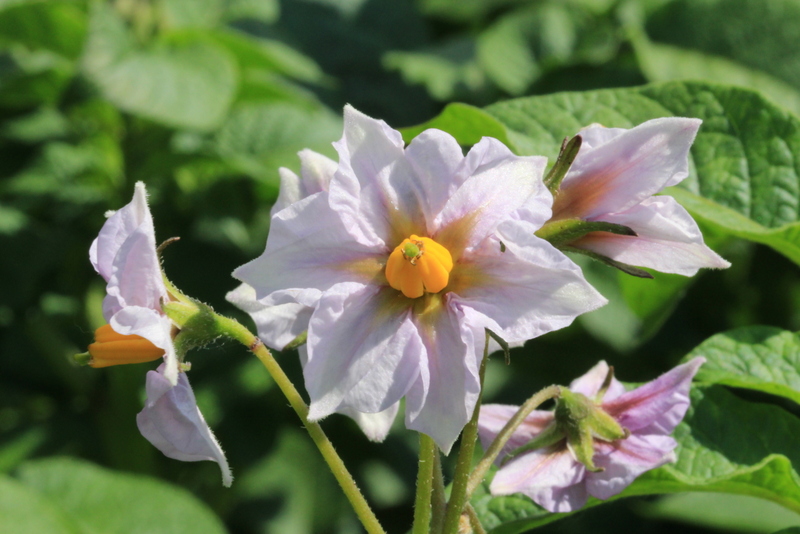Potato Extension
Crystal Green Grower Trials - Potato Expo Poster 2017
Crystal Green is a struvite-based, registered fertilizer. Due to the citrate soluble properties of this mineral, nutrients are only released when in the presence of actively growing roots. Grower trials were conducted in 2015 and 2016 to evaluate the effectiveness of a struvite product, Crystal Green on irrigated Russet Burbank, Umatilla Russet, and Bannock Russet potatoes in Minnesota and North Dakota. In general, there was a positive response to Crystal Green when potatoes were grown in alkaline or acidic soils. Potatoes grown in neutral pH did not have a positive response to Crystal Green.
Focus on Potato: Epidemiology and Management of Potato White Mold
White mold is one of several important foliar diseases that potentially affect potato production due to reductions in tuber yield and increase disease management costs. This presentation will help potato growers and field managers in potato production regions understand how the fungus that cause white mold colonizes host substrates to initiate disease, infects healthy potato foliage, and is most efficiently managed. Environmental and host factors that affect disease spread and progression will be discussed. The rolls of sclerotia in overwintering of the pathogen, of apothecia and ascospores in disease spread, senescent host tissue for initial infection and how they all relate to disease management will be presented. By the end of the presentation, those that listen will know more about the epidemiology of white mold and will be well equipped to manage the disease.
Presentation on Rotational Crop Effects on Potato Production in the Red River Valley
This presentation gives an overview of the effects of planting canola, dry bean, or wheat prior to potatoes. Data from the first potato crop is available and did not have any significant differences in yield or marketable yield.
Dickeya Surveys and Testing Methodology
The National Potato Council has received a number of calls and other contacts regarding the presence of Dickeya in North America and particularly with regard to the role of laboratory testing in making determinations on the presence of Dickeya in seed potato. Here is some information on these topics. This letter came from the NPC.
Focus on Potato: Late Blight Management Under Semi-Arid Conditions
Late blight has the potential to be one of the most destructive diseases for potato growers. Late blight is influenced largely by environmental conditions. Management under semi-arid conditions can be quite different than managing the disease under wet, humid conditions. This presentation outlines effective control practices for growers who raise potatoes under semi-arid conditions. This presentation addresses the effect of irrigation on late blight, fungicide efficacy against late blight, the impact of weather, timing of fungicide applications, the effect of application method on fungicide residue, and the role of post-harvest products.
Give us your ideas for presentations at the International Crop Expo Potato meeting
Please let us know your thoughts on topics you would like to hear about during the potato session at the International Crop Expo on February 22-23, 2017 in Grand Forks, ND.
USDA starts Minituber Laboratory Testing Pilot with Private Laboratories
APHIS will provisionally approve qualified private laboratories to conduct pathogen testing of minitubers (Solanum tuberosum) and plant tissues used for the production of minitubers in support of U.S. export certification beginning August 2016. This pilot will allow APHIS to evaluate the use of private laboratory pathogen test results for phytosanitary certification prior to pursuing implementation through rulemaking.
Final Aphid Alert for 2016
With only 2 trap locations reporting this week and no aphids recovered, this will likely be the last seasonal report for the Aphid Alert Network...
Aphid Alert week of Aug 22-26
Trap capture numbers remain low as do the PVY Risk Index values. As the season winds down and night time temperatures decrease, we expect this to trend through. Several sites did not report this week and if trap contents come in early next week, we will add them to the report.
Blightline August 26, 2016
The late blight that was been confirmed in a potato sample collected in Pembina County, ND earlier this week is US23 genotype. Surprisingly, no additional fields or locations with late blight have been reported in our area. Conditions remain favorable for late blight because of the cool temperatures and spotty showers. Growers should continue to scout frequently for late blight and apply protectant fungicides on a seven-day schedule, including fields that have been abandoned due to water damage. Scouting is especially important in fields along the Canadian border, in Pembina and Walsh counties and in wet fields in northeastern ND and northwestern MN that may be exposed to late blight spore showers. This late blight has the potential to spread to unprotected and abandoned fields near the infected field.
Document Actions





